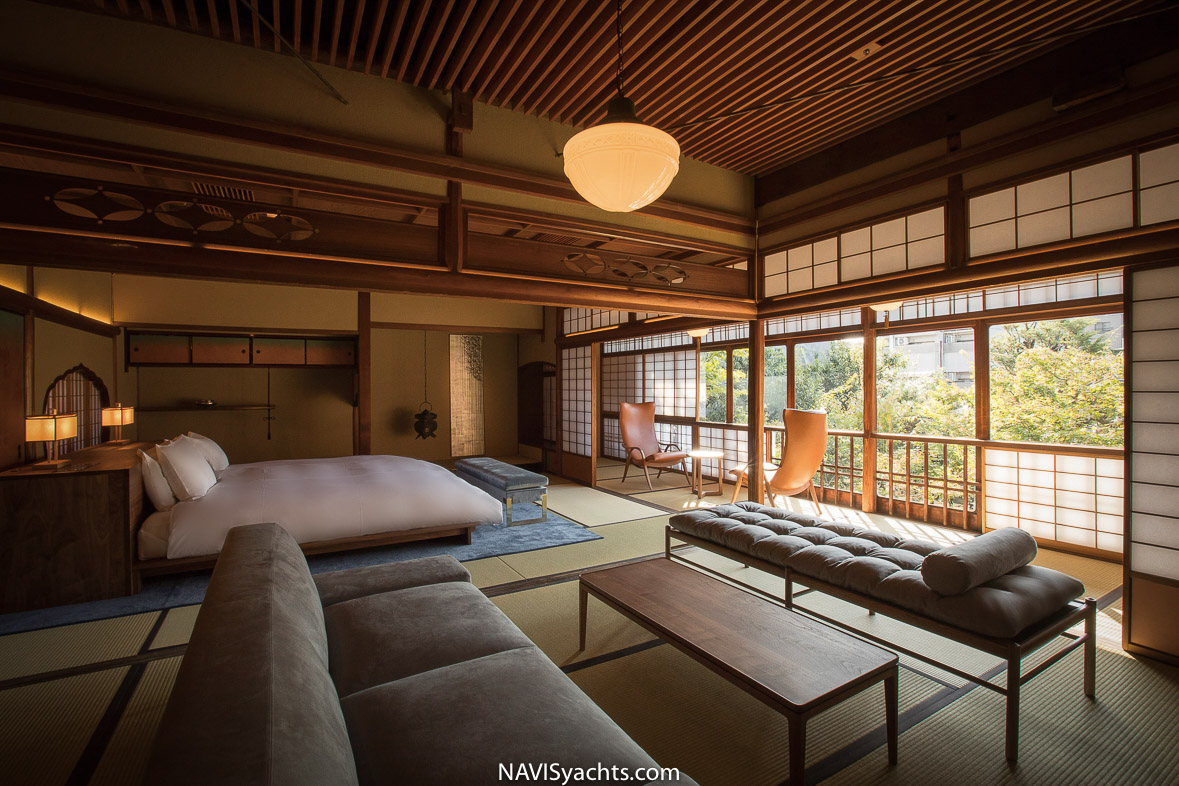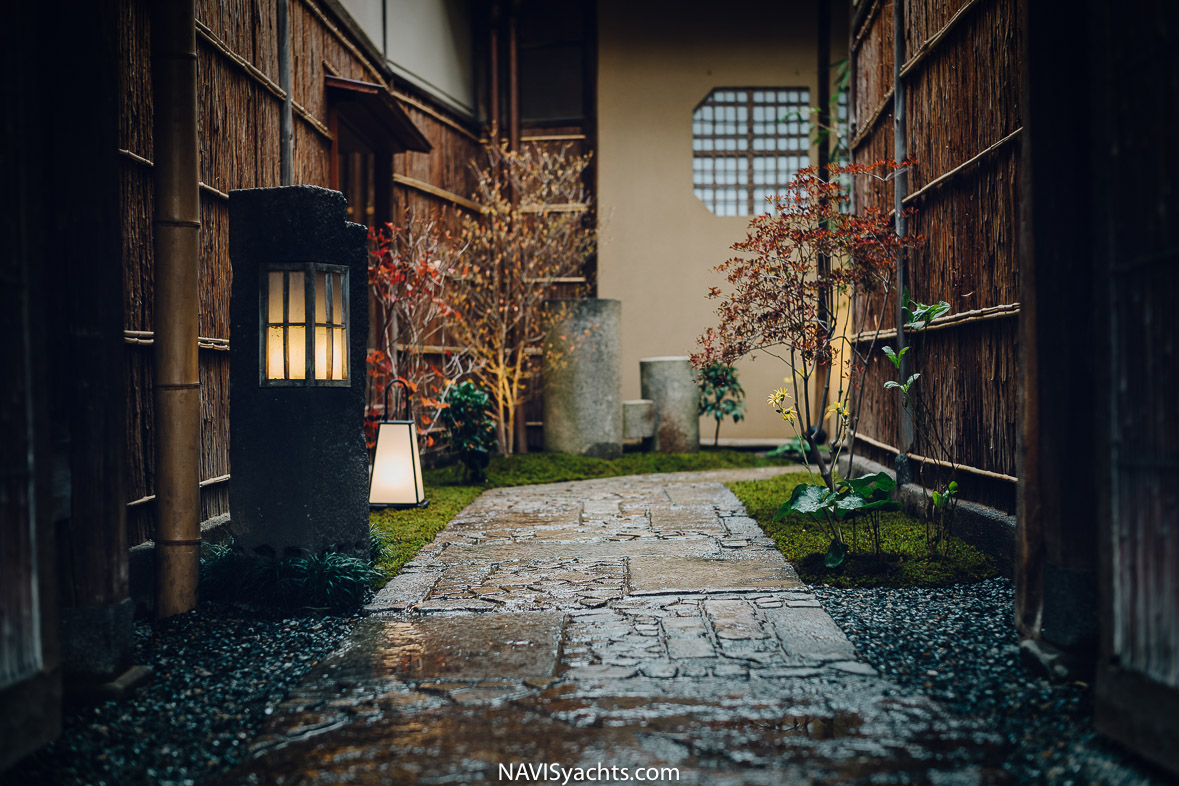Tucked away along the winding streets of Kyoto’s Gion district, popular for its geishas and tea houses, Sowaka is a peaceful haven for weary travelers seeking an authentic experience in this busy city. Few destinations marry technology and modern style with historic detail quite the way Japan does. As Japan’s capital for over a millennium, perhaps Kyoto itself has seen the most success in this blending new and old, maintaining the craftsmanship and artistic intent of its long, storied past and imbuing it in contemporary lifestyle.
In Sanskrit, Sowaka means “may you find happiness,” a blessing that is uttered at the end of a Buddhist scripture. In a harmonious blend of ancient culture and modern design, Sowaka is styled in the great tradition of Japan’s inns or ryokans and opened in late 2018 in a rehabilitated, century-old restaurant. With just 11 rooms, the hotel later debuted a newly-built annex for an additional 12, slightly more modern rooms in March of last year. The evolution of Sowaka as an urban retreat was ideated by rising local architect, Shigenori Uoyi, whose previous work in the city garnered its Koji Fujii award for highly creative design that honors Kyoto cultural heritage. Deftly integrating traditional sukiya style with modern minimalism, the result here is pure, simple luxury: heated floors, high beamed or coffered ceilings, ample room sizes, cedar bathtubs, and the artful use of windows and typical shoji screens to bring the breezes of the outdoor gardens in.

From the street, Sowaka may look like your average Japanese ryokan. But from the moment guests enter, they are warmly welcomed with champagne by lively, engaged staff with an easy command of English. The main public area is subtly scented and tranquil, not your typical bustling hotel lobby here, it is a tranquil and reflective place to check-in, decide on the direction for the day, interact with engaged staff for advice or end a memorable stay.
Sowaka is sensitively crafted to be a living museum that takes you, as hotel management likes to say, “beyond the notion of time.” Comfort and tranquility abound here, and luxuriously so. No two rooms are precisely alike. For the older building, this may seem more of a necessity, but the precision hand-craftsmanship involved in successfully carrying off the modernization of the original structure with the seamless commingling of the new annex creates a serenity that exudes both the ancestral and the contemporary. The final product is well worth the wait to visit this often sold-out hotel and partake, with all five senses savoring the experience.
The team here works diligently to ensure that guests feel thoroughly welcomed, comforted, and valued. Rooms are spacious and high ceilinged, with seating that looks deceivingly spare but feels welcoming. The minibar, stocked with quality beverages, is included with the room. Although there are no massive flat-screen TVs here, there’s wifi throughout, and each room is furnished with a tablet. Most rooms look out onto a serene garden-scape with ponds, and shoji screens slip aside easily to let the outside in. Silky and cossetting bed linens envelop you here and while futons are traditional in ryokans, just sinking into the indulgent LARKOWL mattresses crafted in natural fibers by Iwata, a local crafter, make for a beautiful, well-earned rest after a long trip, or a busy day of meetings, wandering a bamboo grove, or visiting any of the many shrines and temples that make up part of Kyoto’s considerable appeal.
Oh, and then there’s the food. Sowaka’s restaurant, La BOMBANCE, is the latest outpost from young upstart chef Makoto Okamoto. The original La BOMBANCE in Tokyo’s clubby Roppongi district has been earning its Michelin standing for 10 consecutive years since 2008. A dynamic blending of French and traditional Japanese, the menu which changes seasonally, monthly even, highlights Kyoto’s local produce, artisan-crafted temptations, as well as a hand-picked selection of regional wines and, of course, award-winning sake. Kyoto and, in particular, the local Gion district, are awash in dining experiences, but one or two meals here -- a dinner as well as a lunch, perhaps -- at La BOMBANCE should be a requirement. A delightfully imaginative take on the popular kaiseki style, the food at La BOMBANCE soars with its artful combinations of the freshest ingredients and stylish, imaginative presentations. Should you consider dining elsewhere during a longer stay in Kyoto, know that as a guest, you are welcomed back home to an intimate 4-seat bar tended by an engaging mixologist, an experience to be enjoyed. La BOMBANCE is also the breakfast venue solely for Sowaka guests, offering a choice of Japanese or typical western-style dishes, which was imaginatively accomplished: where else can you toast your own toast over flame at the table? It is certainly worthwhile experiencing the Japanese breakfast at least once during your stay, even if your tastes are not so adventurous in the early mornings. Their comforting pairing of miso, rice, and grilled fish to start the day is certainly competitive with the western offerings.
Around Sowaka, the Gion area itself is a district of small, winding streets featuring centuries-old buildings that transport you to an earlier time. This traditional neighborhood is an ideal starting point for exploring Kyoto’s 1500 plus beautiful Buddhist temples and 300 Shinto shrines, as well as some of Japan’s top museums and galleries. Not too far into the central Yagashiyama area is the majestic UNESCO-listed Kiyumizo-dera Temple, built in 780 CE, with its altars, fountains, ritual observances, and impressive statuary. The tranquility of Sowaka is right at home here but, across the river, there is the bustling five block-long Nishiki Market, which, even if you do not consider yourself a foodie, is an adventure in itself.
In its aims to provide a culturally-infused, multi-sensory experience for guests, Sowaka does not disappoint. Depending on the season, the innovative team arranges for ‘insider’ experiences where guests are not stifled by the throngs of tourists that are typical during sakura (cherry blossom), momijigari (autumn leaf-peeping) or during Japan’s biggest, most popular festival, the Gion Matsuri at the Yasaka shrine, just a 3 minute walk away. From private morning tours of temples or after-hours light shows, introduction to the world of geisha (or, locally, geiko), private tea ceremonies, the hotel staff works unceasingly to ensure guests are surprised and delighted. Happiness and blessings abound at Sowaka.



























